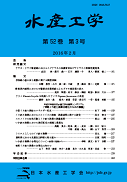52 巻, 3 号
選択された号の論文の12件中1~12を表示しています
- |<
- <
- 1
- >
- >|
-
2016 年 52 巻 3 号 p. 161-170
発行日: 2016年
公開日: 2016/09/01
PDF形式でダウンロード (1776K) -
2016 年 52 巻 3 号 p. 171-176
発行日: 2016年
公開日: 2016/09/01
PDF形式でダウンロード (1632K) -
2016 年 52 巻 3 号 p. 177-184
発行日: 2016年
公開日: 2016/09/01
PDF形式でダウンロード (1455K) -
2016 年 52 巻 3 号 p. 185-187
発行日: 2016年
公開日: 2016/09/01
PDF形式でダウンロード (646K) -
2016 年 52 巻 3 号 p. 189-195
発行日: 2016年
公開日: 2016/09/01
PDF形式でダウンロード (1376K) -
2016 年 52 巻 3 号 p. 197-203
発行日: 2016年
公開日: 2016/09/01
PDF形式でダウンロード (2192K) -
2016 年 52 巻 3 号 p. 205-208
発行日: 2016年
公開日: 2016/09/01
PDF形式でダウンロード (1116K) -
2016 年 52 巻 3 号 p. 209-215
発行日: 2016年
公開日: 2016/09/01
PDF形式でダウンロード (2042K) -
2016 年 52 巻 3 号 p. 217-222
発行日: 2016年
公開日: 2016/09/01
PDF形式でダウンロード (1518K) -
2016 年 52 巻 3 号 p. 223-225
発行日: 2016年
公開日: 2016/09/01
PDF形式でダウンロード (1812K) -
2016 年 52 巻 3 号 p. 227-231
発行日: 2016年
公開日: 2016/09/01
PDF形式でダウンロード (1545K) -
2016 年 52 巻 3 号 p. 233-237
発行日: 2016年
公開日: 2016/09/01
PDF形式でダウンロード (694K)
- |<
- <
- 1
- >
- >|
